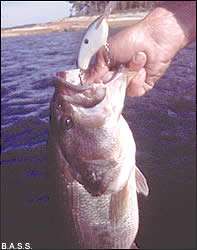
Throughout the ages, mankind has been infatuated with spherical objects. Christopher Columbus sailed into the unknown to prove the world was round. Ancient cultures have worshipped the sun. Men have dreamed of flying to the moon for thousands of years, and finally reached the orb in 1969.Even bass anglers have their own spherical fixation when selecting crankbaits. Columbus had a difficult time convincing the Spanish royalty to fund his expedition, and today’s lure sellers have just about as much trouble persuading Bassmasters to buy flat-sided crankbaits. Whether for deep cranking or burning the shallows, the round, wide wobbling crankbait has become the most popular choice for many applications.Flat, lipless crankbaits have always been fan favorites, but stick a bill on it, and bass anglers treat this flat lure like an ugly duckling. However, pros on the CITGO BASSMASTER Tour know these slim plugs catch bass when the fat ones fail.
On the following pages, three cranking specialists share with BASSMASTER readers their tricks for catching bass on skinny crankbaits.
Spring cranking
Virginia pro Curt Lytle prefers throwing flat-sided crankbaits when the water temperature is below 60 degrees. “They’re really outstanding early and late in the year,” says Lytle, winner of the Missouri Invitational in 2000.
“Most of your flat baits are fairly close to being neutral buoyancy, so they don’t pop up.”Early in the year, Lytle selects flat-sides in red or brown hues to imitate crawfish. The lures’ neutral buoyancy becomes a key factor during this time, because Lytle wants his lure to stay close to the bottom and mimic a fleeing crawfish. He achieves this presentation with a “real grinding retrieve” that constantly bangs the lure’s bill into the clay or rocky floor.Shad pattern flat-sides (pearl, Tennessee shad or chrome) produce best for Lytle in the fall. Since bass seem to suspend more during this time, Lytle runs his shad imitators at a steady pace. He occasionally tries to bump the lure into something, but most of the time, he keeps it running in the middepth zone.
Slick clay and tapering gravel banks are two of Lytle’s favorite areas to throw flat crankbaits. “A lot of times, the flat crankbait will work where other people don’t fish,” he suggests. “For that reason, you can catch fish on a flat crankbait with almost no cover around you.” If the clean banks in a cove all look the same, Lytle recommends targeting the windblown shores first.Lytle prefers skinny crankbaits for shallow water situations. “There are very few flat-sides that will work past 8 feet,” he warns. Most of his slim plugs run between 3 to 7 feet deep.The B.A.S.S. pro relies on three models of flat-sides for various applications. Although he rarely fishes these lures in heavy cover, Lytle occasionally runs a Poe’s RC3 through objects because he believes it deflects better than other flat-sides. He opts for a prototype Hawg Caller crankbait for running in medium cover and prefers the thin-sided Rapala Shad Rap for fishing along open banks. “It doesn’t deflect well off cover, but it does trigger strikes in open water,” claims Lytle.Whenever possible, Lytle tries to match his crankbait with baitfish size, but most of the time he throws larger flat-sides because the lures are easier to cast. He uses spinning tackle for the lightweight No. 7 Shad Rap but selects baitcasting gear (7-foot medium action rod and Shimano Castaic reel) for the rest of his flat plugs. In most situations, Lytle opts for 10-pound-test line. When casting into the wind, however, he pares down to 8-pound test for his spinning gear.While tinkering with these lures, Lytle has discovered that flat-sides work best when left alone. He has tweaked the bills, but his modifications caused the lures to run awry. “Most of them are made of wood, and a lot of wood crankbaits have their own personality anyway, so you tend not to modify them much,” he says.
Clear choice
Paducah, Ky., pro Terry Bolton relies on a Bomber Flat A crankbait in the spring when the water temperature remains in the 40s to mid-50s. He prefers the tight wiggle of the Flat A in clear water over the wide wobble of his other springtime favorite, the round-shaped Rebel Wee R. “It seems like the Flat A is a little better in cleaner water,” he claims.
Baitfish are the main forage of bass in the colder water, so Bolton opts for a crankbait that best resembles the prey. “The profile of a Flat A seems to imitate a shad or a bluegill, while the Wee R is better at imitating a crawfish,” suggests Bolton. He selects flat crankbaits in shad hues for clear water situations; and chartreuse/black, chartreuse/brown or firetiger for stained water.Flat-sides produce best for Bolton along pre-spawn staging areas in creeks or at the mouths of bays. His favorite targets for cranking include 45 degree banks and points or flats close to channel swings. He also likes to run the Flat A through the tops of hydrilla beds. “The lure’s tight wiggle sheds the grass very well,” says Bolton.
The Flat A allows Bolton to cover depths ranging from 2 to 9 feet, depending on the line size he selects. When fishing around cover, Bolton chooses 12-pound test, but scales down to 8- to 10-pound test to give the lure better action and make it run deeper along open banks. He attests the lure runs its maximum depth of 9 feet when tied on 8-pound line.
Bolton cranks the Flat A to the bottom and then employs a slow, steady retrieve. “The Flat A is a little narrower body, so it doesn’t float up as quickly,” he advises. “So once you get the bait down, it does a real good job of staying down.”
The Kentucky angler usually cranks the lure at a steady pace but occasionally varies his retrieve with a stop-and-go presentation. Even though he tries to cover a lot of water during the spring, Bolton favors a slower retrieve that prevents him from fishing too fast, which he has a tendency to do, especially after catching a bass.While testing crankbaits in a swimming pool, Bolton noticed the Flat A has a different deflection angle than round models. “Whenever you hit a rock or something with that flat bait, it has a very erratic action — more erratic than a Wee R or Bomber Model A,” he says. Bolton adds that the Flat A deflects as much as 2 to 3 feet away from an object, whereas a round crankbait usually slides along the object it hits.A 7-foot G. Loomis cranking rod with a Shimano baitcast reel (5.1:1 gear ratio) works best for most of Bolton’s flat-side cranking tactics. However, he does switch to a 6-foot medium-light Loomis spinning rod and a Shimano spinning reel with 8-pound-test line for making long casts to get his lure deeper, or for fishing on blustery days. He notes the Flat A is difficult to throw, since it catches wind and sails like “a butterfly with hiccups.”
Change-up bait
Rick Clunn’s 1984 BASSMASTERS Classic victory on the Arkansas River offers a perfect example of a thin crankbait’s worth to this bass fishing legend. “The first two days, I was catching them on a Bomber 6A and had 24 pounds the first day and 23 pounds the second, but I really felt I was beating the fish up and wearing out the area,” recalls Clunn, who decided to try another lure if he struggled in the final round. “The third day I went in there, and the first couple of passes only had one bite on that bait. So I picked up a flat-sided bait and caught 28 pounds there in water I thought I had beat to death.”
The Missouri pro believes the bass’ lateral line is a sophisticated screening device. “They can differentiate slight details and differences in lures through a hydrodynamic imaging process that we can’t even comprehend,” he says. “What this really tells you is that no bait is necessarily any better than another all the time, but sometimes using different baits is really the key.”In his Angler’s Quest bass fishing classes, Clunn describes how each lure creates vibration and how a bass can detect differences in water displacement, which indicates an injured prey. Since more anglers throw round crankbaits, a flat-side without rattles produces a different vibration, which bass might perceive as a crippled baitfish.
The flat crankbait shines as a change-up lure for Clunn when he fishes reservoirs with grassbeds, such as Sam Rayburn or Seminole. He opts for a subtle presentation when anglers throwing Rat-L-Traps have pounded these lakes for several weeks. “I go right behind guys who have beaten the water to death, and catch fish on that quieter bait,” says Clunn. “It’s not nearly as obtrusive to the fish as those baits that have all the rattles.”
The four time BASS Masters Classic champion uses two models of the Awesome Bait Co. Thundershad — a short-billed version that dives 2 to 3 feet deep, and a long-billed plug capable of descending to 5 feet. His flat crankbait selection includes basic colors: shad and crawfish hues in the spring, shad pattern in summertime and chartreuse in off-color water.Retrieving his skinny crankbaits at a medium to fast clip produces best for Clunn. “Every bait has a signature vibration when you reel it, and you can feel it all the way through the line to the rod tip,” advises Clunn. “A medium to high speed creates that signature in the flat bait that I know generates the majority of the bites.”The flat-side also serves as an alternate lure for a cold weather presentation. While others sweep a suspending Rebel Spoonbill Minnow, Clunn prefers a flat-side, because it casts into the wind better than jerkbaits. The crankbait specialist makes the lure dive by sweeping his rod. Then, he pauses it for a three-count before making the next sweep.Whether sweeping or burning the crankbait, Clunn works the lure with his signature series Bass Pro Shops heavy action 7-foot rod and a high-speed Bass Pro Shops (6.3:1 gear ratio) baitcast reel. When fishing shallow weeds, Clunn ties his lures on 14- to 17-pound-test line, but switches to 12-pound fluorocarbon for sweeping the crankbait in cold, clear water.
Replacing the factory hooks with larger trebles is the only modification Clunn makes to his flat-sided crankbait. “It’s just a good all-around bait,” praises Clunn. “It’s one I always have tied on, and I won’t leave fish without throwing it. That bait has shown me over and over that it will generate strikes when fish quit hitting anything else.”Different vibes for lipless crankbaitsAnglers can now switch to a silent lipless crankbait when bass shy away from the rattling variety.
Ambush Lures manufactures the Ambush Stealth Diver, a silent running lipless crankbait with an internal fluid passageway in its convex nose that creates more vibration. The nose design allows the lure to roll over brush, and its flow-through body design generates water displacement that simulates vibration similar to the tail action of a swimming baitfish. The inner cavity can also be used to hold an Ambush Lure Scent Carrier that emits fish attractant into the water.
Contact: Ambush Lures, P.O. Box 542, Maryville, MO 64468; 660-562-3838; www.AmbushLures.com.





